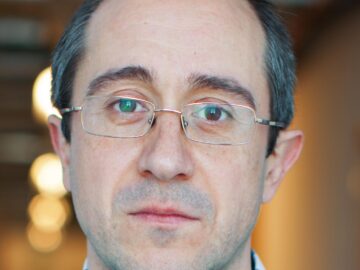
Call:
Email: jlsance@unizar.es
Address:
ABOUT ME
Research Interests
Biomass gasification & pyrolysis, biodiesel production, biodiesel oxidation stability, lignin valorization
PUBLICATIONS
2024
Fonts, Isabel; Lázaro, Cristina; Cornejo, Alfonso; Sánchez, José Luis; Afailal, Zainab; Gil-Lalaguna, Noemí; Arauzo, Jesús
Bio-oil Fractionation According to Polarity and Molecular Size: Characterization and Application as Antioxidants Journal Article
In: Energy & Fuels, 2024, ISSN: 0887-0624, (Publisher: American Chemical Society).
@article{fonts_bio-oil_2024,
title = {Bio-oil Fractionation According to Polarity and Molecular Size: Characterization and Application as Antioxidants},
author = {Isabel Fonts and Cristina Lázaro and Alfonso Cornejo and José Luis Sánchez and Zainab Afailal and Noemí Gil-Lalaguna and Jesús Arauzo},
url = {https://doi.org/10.1021/acs.energyfuels.4c02641},
doi = {10.1021/acs.energyfuels.4c02641},
issn = {0887-0624},
year = {2024},
date = {2024-09-01},
urldate = {2024-09-01},
journal = {Energy & Fuels},
abstract = {Bio-oil obtained from biomass pyrolysis has great potential for several applications after being upgraded and refined. This study established a method for separating bio-oil into different fractions based on polarity and molecular size to extract phenolic and polyphenolic compounds with antioxidant properties. The fractions were analyzed using various spectroscopic and chromatographic techniques, such as GC/MS, FTIR, UV–vis, SEC, DOSY-NMR, 13C-NMR, and 31P-NMR. The antioxidant properties of these fractions were tested by examining their ability to improve the oxidative stability of biodiesel. The results strongly connected the bio-oil’s chemical functionalities and antioxidant power. During solvent fractionation, dichloromethane could extract phenolic structures, which were subsequently size-fractionated. The subfractions with lower molecular weight (in the order of monomers and dimers) outperformed the antioxidant potential of the crude bio-oil. Heavier subfractions from dichloromethane extraction did not show good antioxidant abilities, which was related to the low hydroxy group content. After solvent extraction, phenolic oligomers remained in the water-insoluble/dichloromethane-insoluble fraction, which showed good antioxidant potential despite its low solubility in biodiesel.},
note = {Publisher: American Chemical Society},
keywords = {},
pubstate = {published},
tppubtype = {article}
}
2023
Afailal, Zainab; Gil-Lalaguna, Noemí; Macías, Robert J.; Gonzalo, Alberto; Sánchez, José Luis
Production of Antioxidant Additives and High-quality Activated Biochar from Pyrolysis of Argan Shells Journal Article
In: BioEnergy Research, 2023, ISSN: 1939-1242.
@article{afailal_production_2023,
title = {Production of Antioxidant Additives and High-quality Activated Biochar from Pyrolysis of Argan Shells},
author = {Zainab Afailal and Noemí Gil-Lalaguna and Robert J. Macías and Alberto Gonzalo and José Luis Sánchez},
url = {https://doi.org/10.1007/s12155-023-10652-0},
doi = {10.1007/s12155-023-10652-0},
issn = {1939-1242},
year = {2023},
date = {2023-08-01},
urldate = {2023-08-01},
journal = {BioEnergy Research},
abstract = {An integral valorization route based on a pyrolysis process has been proposed to find sustainable applications for argan shells focused on the simultaneous production of activated biochar and antioxidant additives from bio-oil. The bio-oil obtained in the pyrolysis process was furtherly upgraded (hydrothermal treatment and extraction process) to obtain antioxidant additives. On the other hand, the biochar obtained in the pyrolysis was used as a feedstock to produce high-quality activated biochar (by physical activation with CO2). The increase in the pyrolysis temperature (350–550 °C) hardly affected the pyrolysis products distribution (biochar yields of 28–34 wt.% and bio-oil yields between 51 and 55 wt.%), but it led to a slight decrease in the content of phenolic monomers extracted from bio-oil (from 63 wt.% at 350 °C to 53 wt.% at 550 °C). When these extracted fractions were blended with biodiesel (<1 wt.%), improvements of up to 300% in biodiesel oxidation stability were attained. The hydrothermal treatment of the bio-oil did not show noteworthy effects either on the production or antioxidant performance of the extracted fractions if compared with the fractions extracted from the raw bio-oil. Regarding the valorization of argan shells biochar, the activated biochar prepared from it showed considerable potential as an adsorbent material for CO2 (125 mg of CO2 per g of the activated biochar) or phenols (complete removal of 99.6% in 4 h of contact time). It was characterized by a high BET surface area (up to 1500 m2/g), a high carbon content (up to 95 wt.%), low ash content (around 2 wt.%), and a pH of around 8.},
keywords = {},
pubstate = {published},
tppubtype = {article}
}
Afailal, Zainab; Gil-Lalaguna, Noemí; Fonts, Isabel; Gonzalo, Alberto; Arauzo, Jesús; Sánchez, José Luis
Thermochemical valorization of argan nutshells: Torrefaction and air–steam gasification Journal Article
In: Fuel, vol. 332, pp. 125970, 2023, ISSN: 0016-2361.
@article{Afailal2023,
title = {Thermochemical valorization of argan nutshells: Torrefaction and air–steam gasification},
author = {Zainab Afailal and Noemí Gil-Lalaguna and Isabel Fonts and Alberto Gonzalo and Jesús Arauzo and José Luis Sánchez},
url = {https://linkinghub.elsevier.com/retrieve/pii/S0016236122027946},
doi = {10.1016/J.FUEL.2022.125970},
issn = {0016-2361},
year = {2023},
date = {2023-01-01},
urldate = {2023-01-01},
journal = {Fuel},
volume = {332},
pages = {125970},
publisher = {Elsevier},
keywords = {},
pubstate = {published},
tppubtype = {article}
}
2021
Afailal, Zainab; Gil-Lalaguna, Noemí; Torrijos, María Teresa; Gonzalo, Alberto; Arauzo, Jesús; Sánchez, José Luis
Antioxidant Additives Produced from Argan Shell Lignin Depolymerization Journal Article
In: Energy & Fuels, 2021.
@article{Afailal2021,
title = {Antioxidant Additives Produced from Argan Shell Lignin Depolymerization},
author = {Zainab Afailal and Noemí Gil-Lalaguna and María Teresa Torrijos and Alberto Gonzalo and Jesús Arauzo and José Luis Sánchez},
url = {https://pubs.acs.org/doi/abs/10.1021/acs.energyfuels.1c01705},
doi = {10.1021/ACS.ENERGYFUELS.1C01705},
year = {2021},
date = {2021-01-01},
journal = {Energy & Fuels},
publisher = {American Chemical Society},
abstract = {The present work summarizes the results of an experimental study focused on producing antioxidant additives for biofuels from argan shell lignin. The generation of this waste has noticeably increas...},
keywords = {},
pubstate = {published},
tppubtype = {article}
}
Robaina, Boris Abel Ramos; Reyes, Yanet Guerra; Trujillo, Leonardo Aguiar; Montesino, Francisco Márquez; Pedroso, Daniel Travieso; Machin, Einara Blanco; Machín, Adrian Blanco; Pascual, Rodrigo; Arauzo, Jesús; Gonzalo, Alberto; Sánchez, José Luis
Assessment of fluidized bed gasification of grapefruit solid waste Journal Article
In: Bioresource Technology Reports, vol. 15, no. July, 2021, ISSN: 2589014X.
@article{Robaina2021,
title = {Assessment of fluidized bed gasification of grapefruit solid waste},
author = {Boris Abel Ramos Robaina and Yanet Guerra Reyes and Leonardo Aguiar Trujillo and Francisco Márquez Montesino and Daniel Travieso Pedroso and Einara Blanco Machin and Adrian Blanco Machín and Rodrigo Pascual and Jesús Arauzo and Alberto Gonzalo and José Luis Sánchez},
doi = {10.1016/j.biteb.2021.100782},
issn = {2589014X},
year = {2021},
date = {2021-01-01},
urldate = {2021-01-01},
journal = {Bioresource Technology Reports},
volume = {15},
number = {July},
abstract = {This work assesses the effects of various process temperatures (700, 750, and 800 °C) and equivalence ratio (0.25; 0.30 and 0.35) on gasification of grapefruit (Citrus x paradisi) solid waste (GSW) in a fluidized bed reactor. The experimental results permit the construction and fit tridimensional chart to assess the studied main output variables' behavior for the simultaneous variation of equivalence ratio and process temperature. The better producer gas composition for the grapefruit solid waste gasification was obtained for a process temperature of 800 °C and 0.25 equivalence ratio; the gas yields around 67%, with LHV of 4389 kJ/Nm3, within the spectrum of values reported for other lignocellulosic residues. According to the obtained study results, GSW presents a valuable renewable energy resource for agroindustry. For operation parameters assessed, could be potentially produced 3.49 GJ of thermal energy per ton of GSW gasified.},
keywords = {},
pubstate = {published},
tppubtype = {article}
}

